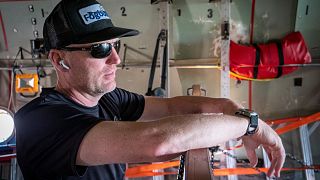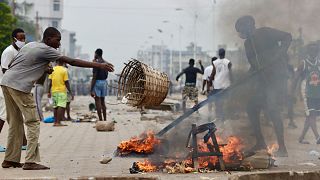South Sudan
Roda Nyawuy took great risks to gather firewood for her family in flood-ravaged South Sudan, wading into murky waters with unseen dangers lurking beneath the surface.
But her family couldn't afford cooking gas or charcoal, so the mother of seven steeled her nerves and hoped for the best, scarcely imagining that a despised weed would offer her a way out.
"Getting firewood was very difficult. There are snakes and thorns in the water," the 40-year-old told AFP in Bentiu, a northern city completely cut off by water after South Sudan's worst floods in recent history.
"It is much easier to make this," she said, gesturing to the white-hot coals powering the small clay oven at her feet.
These briquettes look much like the lumps of charcoal sold in Bentiu's marketplace, but they are not derived from wood.
They are made from water hyacinth: an invasive and fast-growing aquatic plant that has flourished in the four years that South Sudan has endured extreme flooding.
This floating weed is abundant and dense in biomass -- organic material that produces energy, and can be used as a sustainable and cheap cooking fuel.
- Green alternative -
It is everywhere around Bentiu, covering the vast floodplain in dense green patches.
A hated pest in many parts of the world, water hyacinth is proving an unlikely ally for women in Bentiu as climate change reshapes the landscape.
The difficult and dangerous job of collecting firewood falls to women and girls, who must venture long distances to find trees jutting above the surface.
Far outside the mud-earth embankments that protect Bentiu from inundation, they are exposed to injury, water-borne diseases, and sexual violence.
But hyacinth is safely and easily gathered near the water's edge using long rakes, and dried by the sackful under the sun.
The stalks are placed in a sealed metal drum and smouldered over a fire for about 20 minutes, then mixed with water into a paste and shaped into briquettes.
The process requires little training or specialised equipment, said Simon Riak, who oversees the initiative funded by the World Food Programme (WFP).
"It's not like producing local charcoal, which can take three months," he told AFP at a small workshop where women have been learning to make hyacinth briquettes since September.
- Adapt to new reality -
Charcoal of the variety widely used in the developing world is produced by slowly heating wood in earthen kilns with little oxygen until the water has been totally removed.
But the process requires considerable quantities of wood, and is a major driver of deforestation.
Prices for wood-based charcoal have soared in Bentiu since the floods, putting further strain on a local economy desperately short on food and other essentials.
Wood is in short supply and hard to reach, with trees rotting and collapsing in the high water. The scarcity has doubled the price of charcoal in the past year alone, said Riak.
It is hoped that once at scale, hyacinth briquettes could sell for about half the price of charcoal, and provide much-needed income for the women who sell them.
At the moment around 300 people, mostly women, are involved in producing the briquettes and encouraging their uptake among the community.
To overcome initial scepticism, public demonstrations were held.
Tea traders and roadside restaurateurs were asked to test the briquettes to prove they could match the burning power of regular fuels.
"It is a surprise for most people. They don't know that water hyacinth can be used like this," Riak said.
"When they see it.... cook the tea, or cook the food, the community is very happy."
Experts say the floods around Bentiu could take years, even decades, to recede.
Adaptation to this new reality will be essential in a changing world and villagers like Nyawuy are taking the lead.
"I told my neighbours. They are willing to see how it's made and how we use it," she said.
"Those of us who learn to make these briquettes will have an advantage."












01:36
CO2 emissions on track to push Earth beyond 1.5 degree threshold by 2028, report finds.
00:41
Devastating floods in Eastern Cape Leave 78 dead as rescue efforts continue
01:13
Deadly Floods Devastate South Africa’s Eastern Cape: At Least 49 Dead, More Missing
00:24
Greenland and Iceland saw record heat in May
01:39
Hundreds dead and missing after Nigerian town submerged by floods
01:17
South Sudan flood threat returns